President Bush Attends Medal of Honor Ceremony for Woodrow Wilson Keeble
- 指点迷津
- 2024-11-29
- 11
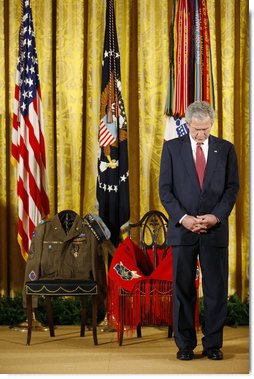 The Medal of Honor is the highest award for valor4 a President can bestow5, and I'm honored recipients6 of the Medal of Honor have joined us. Thank you for coming. During my time in office, I've had the privilege of performing this duty on nine separate occasions. Every ceremony has been inspiring. Many have been joyful7. Some have been poignant8. But I'm not sure I can remember many ceremonies quite like this one.,It's taken nearly 60 years for Master Sergeant9 Woodrow Wilson Keeble to be awarded the medal he earned on the battlefield in Korea. His nominating paperwork was lost, and then it was resubmitted, and then it was lost again. Then the deadline passed, and Woody and his family were told it was too late. Some blamed the bureaucracy for a shameful10 blunder. Others suspected racism11: Woody was a full-blooded Sioux Indian. Whatever the reason, the first Sioux to ever receive the Medal of Honor died without knowing it was his. A terrible injustice12 was done to a good man, to his family, and to history. And today we're going to try to set things right.,Few people worked harder for this day than Woody's family. I thank the members who are with us, including his son, Russell, who is accepting this award on their behalf, along with his cousin -- a cousin.,AUDIENCE MEMBER: Nephew.,THE PRESIDENT: Along with his nephew. I want to welcome you here. Thank you for supporting Woody. Thank you for your understanding, your patience and, most of all, your persistence13.,I also offer special thanks to the determined14 delegations of North and South Dakota, including the Governor of North Dakota and the former Governor of South Dakota. Woody had ties to both Dakotas. Each state claims him as its own. (Laughter.) I think I'm going to stay out of the argument. I want to thank you for carrying Woody's banner to the Pentagon, and to the halls of Congress. You did the right thing.,It's easy to understand why so many people argued so passionately15 for the Medal once you hear the story of what Woody Keeble did. This story unfolded at an important time in our history. The year was 1951. The world was divided by a Cold War. America was under threat and -- some believed -- overmatched and out of heart. The great evil of communism was said to be the future of the world. It was on the advance in Europe, and in China, and on the Asian peninsula of Korea.,
The Medal of Honor is the highest award for valor4 a President can bestow5, and I'm honored recipients6 of the Medal of Honor have joined us. Thank you for coming. During my time in office, I've had the privilege of performing this duty on nine separate occasions. Every ceremony has been inspiring. Many have been joyful7. Some have been poignant8. But I'm not sure I can remember many ceremonies quite like this one.,It's taken nearly 60 years for Master Sergeant9 Woodrow Wilson Keeble to be awarded the medal he earned on the battlefield in Korea. His nominating paperwork was lost, and then it was resubmitted, and then it was lost again. Then the deadline passed, and Woody and his family were told it was too late. Some blamed the bureaucracy for a shameful10 blunder. Others suspected racism11: Woody was a full-blooded Sioux Indian. Whatever the reason, the first Sioux to ever receive the Medal of Honor died without knowing it was his. A terrible injustice12 was done to a good man, to his family, and to history. And today we're going to try to set things right.,Few people worked harder for this day than Woody's family. I thank the members who are with us, including his son, Russell, who is accepting this award on their behalf, along with his cousin -- a cousin.,AUDIENCE MEMBER: Nephew.,THE PRESIDENT: Along with his nephew. I want to welcome you here. Thank you for supporting Woody. Thank you for your understanding, your patience and, most of all, your persistence13.,I also offer special thanks to the determined14 delegations of North and South Dakota, including the Governor of North Dakota and the former Governor of South Dakota. Woody had ties to both Dakotas. Each state claims him as its own. (Laughter.) I think I'm going to stay out of the argument. I want to thank you for carrying Woody's banner to the Pentagon, and to the halls of Congress. You did the right thing.,It's easy to understand why so many people argued so passionately15 for the Medal once you hear the story of what Woody Keeble did. This story unfolded at an important time in our history. The year was 1951. The world was divided by a Cold War. America was under threat and -- some believed -- overmatched and out of heart. The great evil of communism was said to be the future of the world. It was on the advance in Europe, and in China, and on the Asian peninsula of Korea.,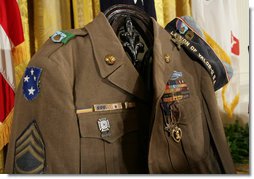 On that peninsula, a battle raged between communist forces in the North and the forces of freedom in the South. And Woody Keeble, a decorated veteran of Guadalcanal, raised his hand to serve his country once again. Woody said he volunteered for Korea because, "somebody has to teach those kids how to fight." And that's exactly what he did. In George Company, he quickly became a mentor16, a teacher, and a legend. He was so strong that he could lift the back of a jeep and spin it around.,Some people knew he had been scouted17 by the Chicago White Sox. He had a heck of an arm, and he threw grenades like a baseball. One soldier remembered the time Woody walked through a mine field, leaving tracks for his men to follow. Another recalled the time Woody was shot twice in the arm and he kept fighting, without seeming to notice.,That fall, Woody's courage was on full display during a major offensive called Operation No Man [sic]. His company was ordered to take a series of hills protecting a major enemy supply line. High up in those hills and manning machine guns were Chinese communist forces. After days of fighting, the officers in Woody's company had fallen. Woody assumed command of one platoon, then a second, and then a third, until one of the hills was taken, and the enemy fled in wild retreat.,That first advance nearly killed him. By the end of the day, Woody had more than 83 grenade fragments in his body. He had bleeding wounds in his arms, chest, and thighs18. And yet he still wanted to fight. So after a day with the medics, he defied the doctor's orders and returned to the battlefield. And that is where, on October 20, 1951, Master Sergeant Woodrow Wilson Keeble made history.,Communist forces still held a crucial hill that was the "pearl" of their defenses. They had pinned down U.S. forces with a furious assault. One soldier said the enemy lobbed so many grenades on American troops that they looked like a flock of blackbirds in the sky. Allied19 forces had tried heavy artillery20 to dislodge the enemy, and nothing seemed to be working. The offensive was failing, and American boys were dying. But our forces had one advantage: Woody was back, and Woody was some kind of mad.,
On that peninsula, a battle raged between communist forces in the North and the forces of freedom in the South. And Woody Keeble, a decorated veteran of Guadalcanal, raised his hand to serve his country once again. Woody said he volunteered for Korea because, "somebody has to teach those kids how to fight." And that's exactly what he did. In George Company, he quickly became a mentor16, a teacher, and a legend. He was so strong that he could lift the back of a jeep and spin it around.,Some people knew he had been scouted17 by the Chicago White Sox. He had a heck of an arm, and he threw grenades like a baseball. One soldier remembered the time Woody walked through a mine field, leaving tracks for his men to follow. Another recalled the time Woody was shot twice in the arm and he kept fighting, without seeming to notice.,That fall, Woody's courage was on full display during a major offensive called Operation No Man [sic]. His company was ordered to take a series of hills protecting a major enemy supply line. High up in those hills and manning machine guns were Chinese communist forces. After days of fighting, the officers in Woody's company had fallen. Woody assumed command of one platoon, then a second, and then a third, until one of the hills was taken, and the enemy fled in wild retreat.,That first advance nearly killed him. By the end of the day, Woody had more than 83 grenade fragments in his body. He had bleeding wounds in his arms, chest, and thighs18. And yet he still wanted to fight. So after a day with the medics, he defied the doctor's orders and returned to the battlefield. And that is where, on October 20, 1951, Master Sergeant Woodrow Wilson Keeble made history.,Communist forces still held a crucial hill that was the "pearl" of their defenses. They had pinned down U.S. forces with a furious assault. One soldier said the enemy lobbed so many grenades on American troops that they looked like a flock of blackbirds in the sky. Allied19 forces had tried heavy artillery20 to dislodge the enemy, and nothing seemed to be working. The offensive was failing, and American boys were dying. But our forces had one advantage: Woody was back, and Woody was some kind of mad.,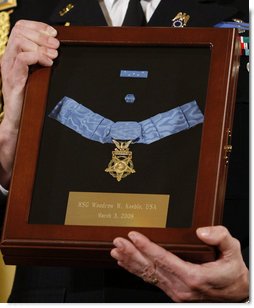 He grabbed grenades and his weapon and climbed that crucial hill alone. Woody climbed hundreds of yards through dirt and rock, with his wounds aching, bullets flying, and grenades falling all around him. As Woody first started off, someone saw him and remarked: "Either he's the bravest soldier I have ever met, or he's crazy." Soldiers watched in awe21 as Woody single-handedly took out one machine gun nest, and then another. When Woody was through, all 16 enemy soldiers were dead, the hill was taken, and the Allies won the day.,Woody Keeble's act of heroism22 saved many American lives, and earned him a permanent place in his fellow soldiers' hearts. Years later, some of those tough soldiers' eyes would fill with tears when they saw Woody again. One said: "He was the most respected person I ever knew in my life." Another said: "I would have followed him anywhere." A third said: "He was awesome23." Those brave boys battled tyranny, held the line against a communist menace, and kept a nation free. And some of them are with us today. We are honored to host you at the White House. We thank you for your courage. We thank you for honoring your comrade in arms. And we thank you for your service to the United States.,As the war ended, Woody went back to North Dakota. In some ways, his return was a sad one. Within a few years, his first wife died. He would suffer from numerous affects of the war. A series of strokes paralyzed his right side and robbed him of his ability to speak. And the wounds he sustained in service to his country would haunt him for the rest of his life.,Yet Woody was not a bitter man. As a member of his family put it: "Woody loved his country, loved his tribe, and loved God." Woody even found love again with a woman named Blossom. Woody may not have been able to speak, but he could still get a message across. He wrote a note asking Blossom to marry him. She told him she needed some time to think about it. So while she was deliberating, Woody put their engagement announcement in the newspaper. (Laughter.) This is a man who was relentless24 in love as well as war. (Laughter.),In his community he was an everyday hero. Even in poor health, he would mow25 lawns for seniors in the summers and help cars out of the snow banks in the winters. He once picked up a hitchhiker who was down on his luck and looking for work. Woody wasn't a rich man, but he gave the man $50. Those who knew Woody can tell countless26 stories like this -- one of a great soldier who became a Good Samaritan.,
He grabbed grenades and his weapon and climbed that crucial hill alone. Woody climbed hundreds of yards through dirt and rock, with his wounds aching, bullets flying, and grenades falling all around him. As Woody first started off, someone saw him and remarked: "Either he's the bravest soldier I have ever met, or he's crazy." Soldiers watched in awe21 as Woody single-handedly took out one machine gun nest, and then another. When Woody was through, all 16 enemy soldiers were dead, the hill was taken, and the Allies won the day.,Woody Keeble's act of heroism22 saved many American lives, and earned him a permanent place in his fellow soldiers' hearts. Years later, some of those tough soldiers' eyes would fill with tears when they saw Woody again. One said: "He was the most respected person I ever knew in my life." Another said: "I would have followed him anywhere." A third said: "He was awesome23." Those brave boys battled tyranny, held the line against a communist menace, and kept a nation free. And some of them are with us today. We are honored to host you at the White House. We thank you for your courage. We thank you for honoring your comrade in arms. And we thank you for your service to the United States.,As the war ended, Woody went back to North Dakota. In some ways, his return was a sad one. Within a few years, his first wife died. He would suffer from numerous affects of the war. A series of strokes paralyzed his right side and robbed him of his ability to speak. And the wounds he sustained in service to his country would haunt him for the rest of his life.,Yet Woody was not a bitter man. As a member of his family put it: "Woody loved his country, loved his tribe, and loved God." Woody even found love again with a woman named Blossom. Woody may not have been able to speak, but he could still get a message across. He wrote a note asking Blossom to marry him. She told him she needed some time to think about it. So while she was deliberating, Woody put their engagement announcement in the newspaper. (Laughter.) This is a man who was relentless24 in love as well as war. (Laughter.),In his community he was an everyday hero. Even in poor health, he would mow25 lawns for seniors in the summers and help cars out of the snow banks in the winters. He once picked up a hitchhiker who was down on his luck and looking for work. Woody wasn't a rich man, but he gave the man $50. Those who knew Woody can tell countless26 stories like this -- one of a great soldier who became a Good Samaritan.,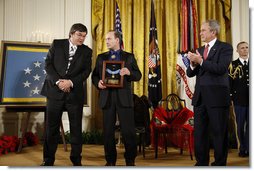 To his last days, he was a devoted27 veteran. He proudly wore his uniform at local events and parades. Sometimes folks who loved him would see that uniform and ask him about his missing medal. They felt he was cheated, yet Woddy never complained. See, he believed America was the greatest nation on Earth, even when it made mistakes. And there was never a single day he wasn't proud to have served our country.,Woody suffered his eighth -- and final -- stroke in 1982. His son, Russell, took him to the hospital and prayed it wasn't the end. But Woody knew, and he wasn't afraid. Woodrow Wilson Keeble died in graceful28 anonymity29, unknown except to the fortunate souls who loved him, and those who learned from him. Russell put it this way: "Woody met death with a smile. He taught me how to live, and he taught me how to die.",I am pleased that this good and honorable man is finally getting the recognition he deserves. But on behalf of our grateful nation, I deeply regret that this tribute comes decades too late. Woody will never hold this Medal in his hands or wear it on his uniform. He will never hear a President thank him for his heroism. He will never stand here to see the pride of his friends and loved ones, as I see in their eyes now.,But there are some things we can still do for him. We can tell his story. We can honor his memory. And we can follow his lead -- by showing all those who have followed him on the battlefield the same love and generosity30 of spirit that Woody showed his country everyday.,At the request of the Keeble family and in accordance with the Sioux tradition, two empty chairs have been placed on this stage to represent Woody and Blossom and to acknowledge their passing into the spiritual world. The Sioux have a saying: "The life of a man is a circle." Well, today, we complete Woody Keeble's circle -- from an example to his men to an example for the ages. And if we honor his life and take lessons from his good and noble service, then Master Sergeant Woody Keeble will serve his country once again.,I want to thank you all for coming. May I ask for God's blessings31 on you and Woody Keeble and the Keeble family. May God continue to bless our country. And now I ask Mr. Hawkins and Mr. Bluedog to join me. Commander Thompson will read the citation32.,
To his last days, he was a devoted27 veteran. He proudly wore his uniform at local events and parades. Sometimes folks who loved him would see that uniform and ask him about his missing medal. They felt he was cheated, yet Woddy never complained. See, he believed America was the greatest nation on Earth, even when it made mistakes. And there was never a single day he wasn't proud to have served our country.,Woody suffered his eighth -- and final -- stroke in 1982. His son, Russell, took him to the hospital and prayed it wasn't the end. But Woody knew, and he wasn't afraid. Woodrow Wilson Keeble died in graceful28 anonymity29, unknown except to the fortunate souls who loved him, and those who learned from him. Russell put it this way: "Woody met death with a smile. He taught me how to live, and he taught me how to die.",I am pleased that this good and honorable man is finally getting the recognition he deserves. But on behalf of our grateful nation, I deeply regret that this tribute comes decades too late. Woody will never hold this Medal in his hands or wear it on his uniform. He will never hear a President thank him for his heroism. He will never stand here to see the pride of his friends and loved ones, as I see in their eyes now.,But there are some things we can still do for him. We can tell his story. We can honor his memory. And we can follow his lead -- by showing all those who have followed him on the battlefield the same love and generosity30 of spirit that Woody showed his country everyday.,At the request of the Keeble family and in accordance with the Sioux tradition, two empty chairs have been placed on this stage to represent Woody and Blossom and to acknowledge their passing into the spiritual world. The Sioux have a saying: "The life of a man is a circle." Well, today, we complete Woody Keeble's circle -- from an example to his men to an example for the ages. And if we honor his life and take lessons from his good and noble service, then Master Sergeant Woody Keeble will serve his country once again.,I want to thank you all for coming. May I ask for God's blessings31 on you and Woody Keeble and the Keeble family. May God continue to bless our country. And now I ask Mr. Hawkins and Mr. Bluedog to join me. Commander Thompson will read the citation32.,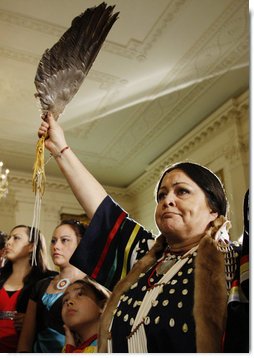 COMMANDER THOMPSON: The President of the United States of America, in the name of Congress, takes pride in presenting the Medal of Honor to Master Sergeant Woodrow W. Keeble, United States Army, for conspicuous33 gallantry and intrepidity34, at the risk of his life, above and beyond the call of duty:,In action with an armed enemy near Sangsan-ni, Korea, on 20 October, 1951. On that day, Master Sergeant Keeble was an acting35 platoon leader for the support platoon in Company G, 19th Infantry36, in the attack on Hill 765, a steep and rugged37 position that was well defended by the enemy. Leading the support platoon, Master Sergeant Keeble saw that the attacking elements had become pinned down on the slope by heavy enemy fire from three well-fortified and strategically placed enemy positions. With complete disregard for his personal safety, Master Sergeant Keeble dashed forward and joined the pinned-down platoon. Then, hugging the ground, Master Sergeant Keeble crawled forward alone until he was in close proximity38 to one of the hostile machine-gun emplacements. Ignoring the heavy fire that the crew trained on him, Master Sergeant Keeble activated39 a grenade and threw it with great accuracy, successfully destroying the position. Continuing his one-man assault, he moved to the second enemy position and destroyed it with another grenade. Despite the fact that the enemy troops were now directing their firepower against him and unleashing40 a shower of grenades in a frantic41 attempt to stop his advance, he moved forward against the third hostile emplacement, and skillfully neutralized42 the remaining enemy position. As his comrades moved forward to join him, Master Sergeant Keeble continued to direct accurate fire against nearby trenches43, inflicting44 heavy casualties on the enemy. Inspired by his courage, Company G successfully moved forward and seized its important objective. The extraordinary courage, selfless service, and devotion to duty displayed that day by Master Sergeant Keeble was an inspiration to all around him and reflected great credit upon himself, his unit, and the United States Army.,(The Medal is presented.) (Applause.),END 2:51 P.M. EST
,
COMMANDER THOMPSON: The President of the United States of America, in the name of Congress, takes pride in presenting the Medal of Honor to Master Sergeant Woodrow W. Keeble, United States Army, for conspicuous33 gallantry and intrepidity34, at the risk of his life, above and beyond the call of duty:,In action with an armed enemy near Sangsan-ni, Korea, on 20 October, 1951. On that day, Master Sergeant Keeble was an acting35 platoon leader for the support platoon in Company G, 19th Infantry36, in the attack on Hill 765, a steep and rugged37 position that was well defended by the enemy. Leading the support platoon, Master Sergeant Keeble saw that the attacking elements had become pinned down on the slope by heavy enemy fire from three well-fortified and strategically placed enemy positions. With complete disregard for his personal safety, Master Sergeant Keeble dashed forward and joined the pinned-down platoon. Then, hugging the ground, Master Sergeant Keeble crawled forward alone until he was in close proximity38 to one of the hostile machine-gun emplacements. Ignoring the heavy fire that the crew trained on him, Master Sergeant Keeble activated39 a grenade and threw it with great accuracy, successfully destroying the position. Continuing his one-man assault, he moved to the second enemy position and destroyed it with another grenade. Despite the fact that the enemy troops were now directing their firepower against him and unleashing40 a shower of grenades in a frantic41 attempt to stop his advance, he moved forward against the third hostile emplacement, and skillfully neutralized42 the remaining enemy position. As his comrades moved forward to join him, Master Sergeant Keeble continued to direct accurate fire against nearby trenches43, inflicting44 heavy casualties on the enemy. Inspired by his courage, Company G successfully moved forward and seized its important objective. The extraordinary courage, selfless service, and devotion to duty displayed that day by Master Sergeant Keeble was an inspiration to all around him and reflected great credit upon himself, his unit, and the United States Army.,(The Medal is presented.) (Applause.),END 2:51 P.M. EST
,President Bush Meets with Public Safety Officer Medal of Honor Recipients
President Bush Presents Medal of Honor to Private First Class Ross Andrew McGinn
President Bush Attends Armed Forces Farewell Tribute in Honor of General Peter P
President Bush Presents the Medal of Honor to Lieutenant Col
President Bush Attends Congressional Gold Medal Ceremony Honoring the Dalai Lama
President Bush Attends Veterans of Foreign Wars National Con
President Bush Attends Secretary of State's Dinner with Annapolis Conference Par
President Bush Attends Council of the Americas
President Bush Discusses Congress's Legislative Priorities for the Remainder of
President Bush Attends Dedication of 9/11 Pentagon Memorial(Sept.11,2008)
本文由明日于2024-11-29发表在生活百科-红苹果乐园,如有疑问,请联系我们。
文章摘自:http://hpgly.com/post/22345.html










![[流言板]雷尔森传中,穆科科近距离射门打飞](/zb_users/upload/2024/12/3111596453046865195.gif)
发表评论